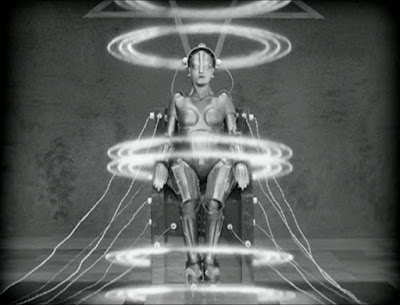Metropolis Film Review
The 1927
film Metropolis is the quintessential
expressionist Sci-Fi film. Complete with a maiden in distress, a mad professor
and an insane robot on the loose, this film set the trope for many films that
would come. As stated by Roger Ebert; Metropolis does what many great films
do, creating a time, place and characters so striking that they become part of
our arsenal of images for imagining the world. Lang filmed for nearly a year,
driven by obsession, often cruel to his colleagues, a perfectionist madman, and
the result is one of those films without which many others cannot be fully
appreciated
The
director, Fritz Lang (who also directed another trail blazing movie, The Cabinet of Dr Caligari), uses several
innovative techniques to create this timeless and hugely influential film;
including be the first film to use a true mix of camera angles and shots.
Previous films such as Dr Caligari
had only used a static camera, with actors and actresses waling in front of the
camera and then back out of the frame, much the same as a theatre performance.
In Metropolis, we see a combination
of the static shots and well as shots that are considered far more modern than this
period, including a hand-held shot. This not only became possible because of
improved technology as well as a new combination of on location filming, miniatures
and traditional sets. This creates a much more interactive, realistic and immersive
visual narrative. This flow of narrative is also aided by a reduced number of
Intertitles when compared to previous films. In Metropolis, Lang only uses
Intertitles for key dialogue that either could not be otherwise understood or
must be ensured to be noticed.
“In the handling
of light, the Germans have been well abreast with the times, and their
cleverness in working out unique effects, such as the travelling concentric
rings of light moving through one another in the metamorphism scene in Metropolis (fig. 1), has often baffled the
American experts.” Writes Sime in his 1927 review of the film. Lang also uses a
combination of mirrors to create the illusion of the actors running inside
miniatures, as well as showing some of the first dollying techniques. This was
the first truly “modern” film. The recently restored footage that we watched
makes it easy to see how the audiences at the time would have found the movie incredible.
This could have been a black and white film of today, rather than being nearly
over 90 years old.
Fig.1 The Metamorphosis (1927)
Metropolis
also presents itself as a timeless social commentary. Depicting the seemingly
endless gap between the haves and have-nots, the upper and lower classes. In
Metropolis this is shown arguably better than any other film. The simplicity
and strength of the contrast between the grey, clone like appearance of the
workers in the dark undercity (fig. 2) and the individuality, light of the upper city (fig. 3) as
well as the softened edges to the shots in the wealthier areas. “Here the producer shows the laborers living in tall buildings
underground, while the families of the wealthy enjoy the fresh air and sunshine
atop a great skyscraper.” As Mordaunt Hall
says. This was a complete reflection of what was going on in the real world. As
industry boomed in the lead up to the wall street crash, there was an
increasing section of society that was treated as part of the machine, with
little to no worth. Lang’s film would have been truly shocking to the upper
classes and have resounded with the less fortunate.
Fig. 2 The Worker's City (1927)
Fig. 3 The Over city (1927)
Overall,
I think it can truly be said that Lang was one of the trendsetters and leaders
of the modern film movement, leading to where we are now, and are going to in
the future. Without the rich past of film that Metropolis contributes to, we
would not have a film industry anything like the one we know today.
References
Ebert,
Roger (2010) Great movie Metropolis.
At: http://www.rogerebert.com/reviews/great-movie-metropolis-2010-restoration-1927
(Accessed on 02/10/2017)
Hall,
Mordaunt (1927) A Technical Marvel.
At: http://www.nytimes.com/movie/review?res=9A05E2D8143BE13ABC4F53DFB566838C639EDE
(Accessed on 02/10/2017)
tanineallison
(2012) The Magic of Metropolis (Fritz
Lang 1927) [online blog] In: Movie
Magic: Special & Visual effects from 1896 to now. At: https://emoryfx.wordpress.com/2012/09/12/the-magic-of-metropolis-fritz-lang-germany-1927/
(Accessed on 02/10/2017)
Sime, Metropolis. Variety, New York, 16th
March 1927
List of Illustrations
Figure 1. The Metamorphosis (1927) [Film capture] At: http://www.theaterjones.com/images/large/l_550521150132.jpg (Accessed on 02/10/2017)
Figure 2. The Worker's City (1927) [Film capture] At: https://fanwithamovieyammer.files.wordpress.com/2013/06/metropolis-2.jpg (Accessed on 02/10/2017)
Figure 3. The Over City (1927) [Film Capture] At: http://www.voxeurop.eu/files/images/article/2034.jpg?1261590241 (Accessed on 02/10/2017)






Hi Eleanor,
ReplyDeleteYou have made some very pertinent observations here, around the depiction of the class system ad also around the technical aspects of the film.
Couple of things... Fritz Lang didn't actually direct 'Dr Caligari' - that was Robert Wiene!
When you use a quote, you need to reference it after the quote, with the surname and the date, in brackets, so ...
"Metropolis does what many great films do, creating a time, place and characters so striking that they become part of our arsenal of images..." ( Ebert, 2010)
...for example. Actually, I'm not sure where your Ebert quote finishes, as you have not used speech marks to highlight it..
Make sure that you remember to italicise the film titles, and be careful that you don't slip into using the first person, as you have done in the final paragraph; better something along the lines of,
"Overall, it could truly be said that Lang was one of the trendsetters and leaders of the modern film movement."